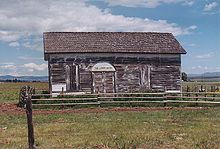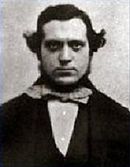- Church of the Firstborn (Morrisite)
-
For other uses, see Church of the Firstborn (disambiguation).
The Church of the Firstborn was a sect of the Latter Day Saint movement that formed as an offshoot of The Church of Jesus Christ of Latter-day Saints in 1861 and was involved in the Morrisite War. Its adherents were known as Morrisites, and schismatic sects that emerged from it were extant until 1969.
Contents
History
Origins
In 1857, Joseph Morris, an English convert to The Church of Jesus Christ of Latter-day Saints, reported receiving revelations naming him the Seventh Angel from the Book of Revelation. He wrote Brigham Young, seeking recognition of his calling from the church.[1] Young did not respond to Morris's request.
In 1860, Morris began to collect followers to a group that became known as the Morrisites. In February 1861, John Taylor and Wilford Woodruff excommunicated Morris from the LDS Church.[2] On April 6, 1861, Morris and his followers organized the Church of the Firstborn and called all of his followers to gather at Kingston (Kington) Fort, a 3-acre (12,000 m2) fort on the Weber River which had been abandoned in 1858.[3] By Fall 1861, the group contained several hundred followers.
Morris told his followers that the Second Coming was imminent and not to bother with planting crops. They may have trampled some of their crops into the ground as evidence of their faith.[2] The group pooled available supplies and waited at Kingston Fort.
Membership
An eight-page Roll of Membership, Names of Persons Baptized into the Fulness of the Gospel was published in San Francisco in 1886.[4] An introduction to the roll reads: "Names of persons baptized during the administration of Joseph Morris, at South Weber, Utah Territory, in the years of 1861 and 1862." The Roll of Membership then lists alphabetically the names of 430 individuals. At the conclusion of the list the publisher notes: "All the names that we found in the record book are in this list. We feel assured that there were many persons baptized whose names were not recorded."[5]
Leadership
A copy of the Roll of Membership housed in the Archives of the Community of Christ includes notations in pencil identifying those in positions of authority next to the following individuals: John Banks, Prescy.; John Cook, Apostle; Richard Cook, Presidency; James Cowan, Apostle; James Dove, apostle; John R. Eardley, Apostle; Mark Hill Forscutt, Apostle; Gudmund Gudmundson, Apostle; William Harris, Bishop; Niels Jacobson, Apostle; John E. Jones, Apostle; William Kendell, Apostle; R. J. Livingstone, Apostle; James Mather, Apostle; John Parson, Apostle; Abraham Taylor, Apostle; John Trolsen, Apostle.
Morrisite War
By spring 1862, food was scarce and some members were becoming discontented. Morris repeatedly designated certain days for the Second Coming, only to have those days pass uneventfully.[6] Each time this happened, a handful of members would recover their possessions from the community pool and leave the congregation.
With the steady outflux of members the question of property entitlement became contentious. Those who stayed behind felt those who left were taking better stock and other items than they had initially contributed to the community pool. Soon after three departing members — William Jones, one of Morris's first converts, John Jensen, and Lars C. Geertsen — vowed revenge after what they perceived as an unfair reckoning, they seized a load of wheat en route from Kingston to Kaysville for milling. The Morrisites sent a group of men after them, and the group soon captured the three and the wheat. The church held the men prisoner in a small cabin, to be "tried by the Lord when he came."[1]
Eventually, the Utah territorial militia was ordered to arrest Morris and the other leaders of the church. On June 15, 1862, Morris was killed in a skirmish and other Morrisite leaders were taken prisoner.
A monument commemorating the Morrisite War stands in South Weber, Utah.
Scattering and regathering
 A Morrisite meetinghouse in Race Track, Powell County, Montana with the inscription "The Lords House."
A Morrisite meetinghouse in Race Track, Powell County, Montana with the inscription "The Lords House."
Although seven Morrisites were convicted of murder and 66 others were convicted of resisting arrest, territorial governor Stephen S. Harding pardoned them all three days after being convicted, and the Morrisites scattered across the western United States. Ultimately, many of the members of the church began to regather in Deer Lodge County, Montana, under the leadership of George Williams, who declared himself to be the "Prophet Cainan" and Morris's rightful successor.[1] In January 1879, Williams prophesied that Deer Lodge County would be the site of the Second Coming of Christ.
Williams was frequently away from Montana, living mostly in Salt Lake City, Utah and England. Williams recorded many revelations that he said he received from God, and also authored St. Ann's Hill Record, which he claimed was a record of ancient origin.[1]
Schism and extinction
After Williams died in 1882, the church divided into a number of schisms, each claiming to be led by Williams's rightful successor. The largest group, based in Montana, were led by John R. Eardley, who renamed the church the Church of Jesus Christ of Saints of the Most High. By the 1950s, most of the members of the church had died and it was officially disbanded in 1969.[1]
Teachings
Twenty-four years after the death of Joseph Morris a collection of his "Revelations, Articles, and Letters" were published by George S. Dove & Company in 1886 under the title The Spirit Prevails. The revelations were recorded between 1857 and 1862 and constituted sacred scripture for Morris's followers.[7]
Like most Latter Day Saint denominations, the Church of the Firstborn taught that Joseph Smith, Jr. was a prophet of God. The church taught that Smith's rightful successor after his death was James J. Strang, and that Strang was succeeded by Joseph Morris.
What set the Church of the Firstborn apart from the majority of Latter Day Saint sects was its belief in reincarnation. Called "baby resurrection" by the church, Morris and Williams taught that reincarnation was taught by Joseph Smith, Jr. and that the majority of other Latter Day Saint sects are in apostasy for rejecting these teachings. Each of the successive leaders of the church were believed to be the reincarnation of a significant prophet of old: Joseph Smith was the reincarnation of Mormon and the Apostle Paul; Joseph Morris was the reincarnation of Moses; and George Williams was the reincarnation of Cainan. Morris prophesied that Jesus would be reincarnated and born to an Arab in Jerusalem in 1909; some have identified Dr. Dahesh as the fulfilment of this prophecy.[8]
The Church of the Firstborn rejected other teachings of Brigham Young and the LDS Church, including plural marriage, restrictions on the priesthood being given to black people, temple ordinances, and blood atonement.
Bahá'ís Under the Provisions of the Covenant
One of Williams' prophesies was that Deer Lodge, Montana would be the site of the Second Coming of Christ. This prophecy was discovered by leaders of the Bahá'ís Under the Provisions of the Covenant (BUPC) founded by Leland Jensen and was considered a confirmation of Jensen's prophetic calling. Jensen taught that the Montana State Prison in Deer Lodge, where he had been incarcerated, was actually Ezekiel's Temple. In a 1991 press release the BUPC explained: "The appointment of the Second IBC (International Baha'i Council) is an epic-making event that parallels the announcement of the return of Jesus in Ezekiel's Temple in Deer Lodge. This event was heralded by the migration of the Morrisites to Deer Lodge, Montana under the direction of the Mormon prophet, George Williams, as John the Baptist heralded Jesus on his first coming. In April of 1863, about the same time Bah'u'llah made his proclamation in Baghdad, Iraq the Morrisites came to Deer Lodge by the instruction of George Williams to 'prepare the way of the Lord,' the second coming of Jesus whose mission is to establish the New World Order..."[9]
See also
- Gudmund Gudmundson
- William W. Davies
- James Brighouse
Factional breakdown: New restoration sects
Sects in the Latter Day Saint movement
New restoration sectsChurch of Christ
Organized by: Joseph Smith, Jr.
Joseph Smith's original 1830
organization; multiple sects currently
claim to be true successor1860
(Reorganized)1844 (trust reorganized)
1851 (incorporated)The Church of
Jesus Christ
of Latter-day Saints
Organized by: Brigham Young
and Quorum of the Twelve
14 million membersCommunity of Christ
(Reorganized Church of Jesus
Christ of Latter Day Saints)
Organized by: Joseph Smith III
More then 250,000 membersNew restoration
sects.1857 1942 1861 Church of the
Potter Christ
Organized by: Arnold Potter
defunctAaronic Order
Organized by: M. L. Glendenning
Less then 1,000 members1
9
5
1Zion's Order, Inc.
Organized by: Merl Kilgore
approx. 100 membersChurch of the Firstborn
(Morrisite)
Organized by: Joseph Morris
defunct1
8
8
4Order of Enoch
Organized by: James Brighouse1861 1955 1866 1882 Church of Jesus Christ
of Latter Day Saints
(Gibsonite)
Organized by: Walter M. Gibson
defunctPerfected Church of
Jesus Christ of Immaculate
Latter-day Saints
Organized by: William C. ConwayKingdom of Heaven
Organized by: William W. Davies
defunctChurch of Jesus Christ
of Saints of
the Most High
Organized by: John R. Eardley
defunct1983 2007 Church of Jesus Christ
(Bullaite)
Organized by: Art BullaLatter Day Church
of Jesus Christ
Organized by: Matthew P. GillNotes
- ^ a b c d e C. LeRoy Anderson Morrisite Collection. Marie Eccles-Caine Archive of Intermountain Americana. Utah State University Libraries: Special Collections and Archives.
- ^ a b Kenneth Godfrey, "The Morrisites" in Utah History Encyclopedia.
- ^ Ruth Malan, "Three-day war focus of new monument", Standard-Examiner (Ogden, UT), 2006-11-02. Pluses section.
- ^ For more information on Dove see Richard Neitzel Holzapfel, “The Flight of the Doves from Utah Mormonism to California Morrisitism: The Saga of James and George Dove.” in Differing Visions: Dissenters in Mormon History edited by Roger Launius and Linda Thatcher. Chicago: University of Illinois Press, 1994. 196-219.
- ^ For a list of individuals see Geo. Dove's Roll of Membership RootsWeb, MORRISITES-L Archives
- ^ G.M. Howard, "Men, Motives, and Misunderstandings: A New Look at the Morrisite War of 1862".
- ^ Morris, Joseph (1886). The "spirit prevails". G.S. Dove; J.A. Dover & Co., printers. pp. 684. http://books.google.com/books?id=1jZDAAAAIAAJ&printsec=titlepage&source=gbs_summary_r&cad=0.
- ^ See, e.g., Darrick Evenson, "An (sic) Brief History of THE CHURCH OF THE FIRSTBORN (The Morrisites): Founded by the Prophets Joseph Morris and George Williams.
- ^ Anderson, C. LeRoy, Joseph Morris and the Saga of the Morrisites (revisited), (Logan, Utah: Utah State University Press, 2010), 214-218.
Categories:- Apocalypticists
- Religious organizations established in 1861
- Defunct Latter Day Saint denominations
- 1969 disestablishments
- Organizations based in Utah
- Latter Day Saint movement in Utah
- New restoration sects in the Latter Day Saint movement
Wikimedia Foundation. 2010.

